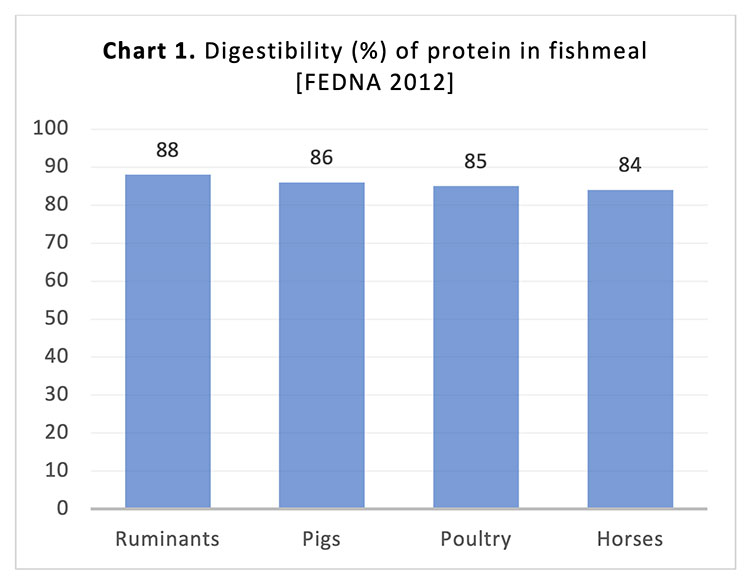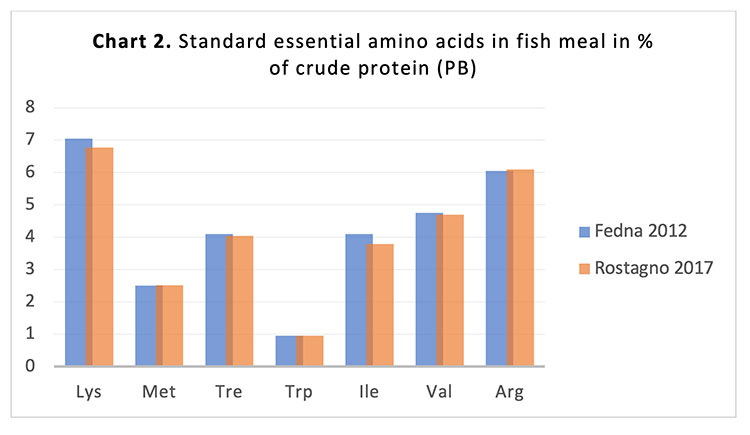Fish meal
Fish meal is a high-protein product (Alfonso Valenzuela, Julio Sanhueza, and Fernando de la Barra 2012) that comes from fish that has undergone heat, pressing and desiccation processes to separate oil and water. Its nutritional value depends not only on the origin, but also on its freshness, temperature, and storage conditions.

Image 1. Flowchart to obtain fish meal.
Nutritive values of fish meal
It is a high-protein product that, in turn, contains high concentrations of essential amino acids, compounds necessary for the proper functioning of the body. In addition, its protein contains very few antinutritive factors, unlike meals of plant origin such as soybean, so it is more digestible, especially in young animals.
Therefore, its main nutritional value lies in the presence of highly bioavailable essential amino acids, that is, those assimilable by animals. Among the most important amino acids is lysine, and it is often used as a reference for the quality of fishmeal and used by formulation programs to determine the inclusion percentages of this ingredient.

Calculation of the real amino acid content in fishmeal
During the extraction process to extract the oil and obtain the fishmeal, high temperatures of approximately 100°C for 20 minutes are applied (Blas et al. 2019). This process affects the nutritional value of fish meal, as it reduces the bioavailability and partly destroys amino acids. In addition, if the conditions during the storage of the fish meal are inadequate, such as high temperatures, this decrease in the nutritional value may be even more significant (Blas et al. 2019).
For this reason, it is essential to evaluate the actual amount of amino acids present in fish meal and take it into account during formulation. If, otherwise, the standard values for this ingredient are used (which are calculated from the nitrogen content and the percentages of each amino acid per unit of crude protein) it is possible that the final diet provides insufficient amounts of essential amino acids, in particular lysine, affecting animal’s welfare, health, and performance.
Near infrared spectroscopy (NIR) is the tool that should be used to know the nutritional values of the ingredients, including the amino acid content. It uses infrared light to analyze a sample’s nutritional composition, so that these values can be used for the formulation of the feed.

Use of lysine supplements when fish meal’s amino acid profile is of a poor quality
Lysinee and other essential amino acids need to be supplied through the diet and are usually in high amounts in protein-based ingredients such as fish meal or other synthetic ingredients that help to supply the proper amount of these essential components until the animals’ needs are completely covered.
In this sense, feed formulation programs use, as the main source of lysine, the ingredient with the lowest cost per unit of this amino acid. This way, if fish meal is affordable and has a high nutritional value, it will be the program’s first choice as a source for lysine. However, if its amino acid content is low, or it is pricey, synthetic lysin will become first-choice.
This is why to formulate diets with adequate lysine content and an optimized price, fishmeal’s amino acid profile needs to me analyzed.
This is because nutritional standard values for this ingredient may not meet the reality, as they do not consider that amino acids can be destroyed during the high temperatures to which fish is exposed during the processing process and storage.
Nutritionists need to know the real cost per unit of lysine and consider it when they formulate the diets to prevent amino acid deficiencies and make feed affordable.
How can we help you?
In Delta Labs, we offer the feed formulation and analysis service to optimize feed composition and adjust it to the requirements of the target species. We can also recommend you the best methods to analyze the ingredients’ amino acids and the best ways to use fishmeal.
We also offer a Diagnostic by Imageservice that includes the evaluation of the problems by a specialized veterinary team and the emission of a report with a presumptive diagnosis and the recommendations to solve the issue.
To use these services, please contact us through our webpage www.globalvetslab.com or email at info@globalvetslab.com
References
Alfonso Valenzuela, B., C. Julio Sanhueza, and D. Fernando de la Barra. 2012. “El Aceite de Pescado: Ayer Un Desecho Industrial, Hoy Un Producto de Alto Valor Nutricional.” Revista Chilena de Nutricion 39(2): 201–9.
Blas, C. de, P. Carcía-Rebollar, M. Gorrachategui, and G.G. Mateos. 2019. Tablas FEDNA de composición y valor nutritivo de alimentos para la fabricación de piensos compuestos FEDNA (Fundación Española Para El Desarrollo de La Nutrición Animal). 4th ed. Madrid. http://www.fundacionfedna.org/ingredientes-para-piensos.